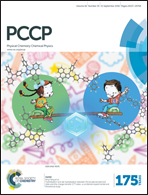Organic heterocyclic molecules become superalkalis†
Abstract
An organic molecule which behaves like a superalkali has been designed from an aromatic heterocyclic molecule, pyrrole. Using first-principles calculation and a systematic two-step approach, we can have superalkali molecules with a low ionization energy, even lower than that of Cs. Couple cluster (CCSD) calculation reveals that a new heterocycle, C3N2(CH3)5 derived from a well-known aromatic heterocycle, pyrrole (C4H5N) has an ionization energy close to 3.0 eV. A molecular dynamics calculation on C3N2(CH3)5 reveals that the structure is dynamically stable.


 Please wait while we load your content...
Please wait while we load your content...